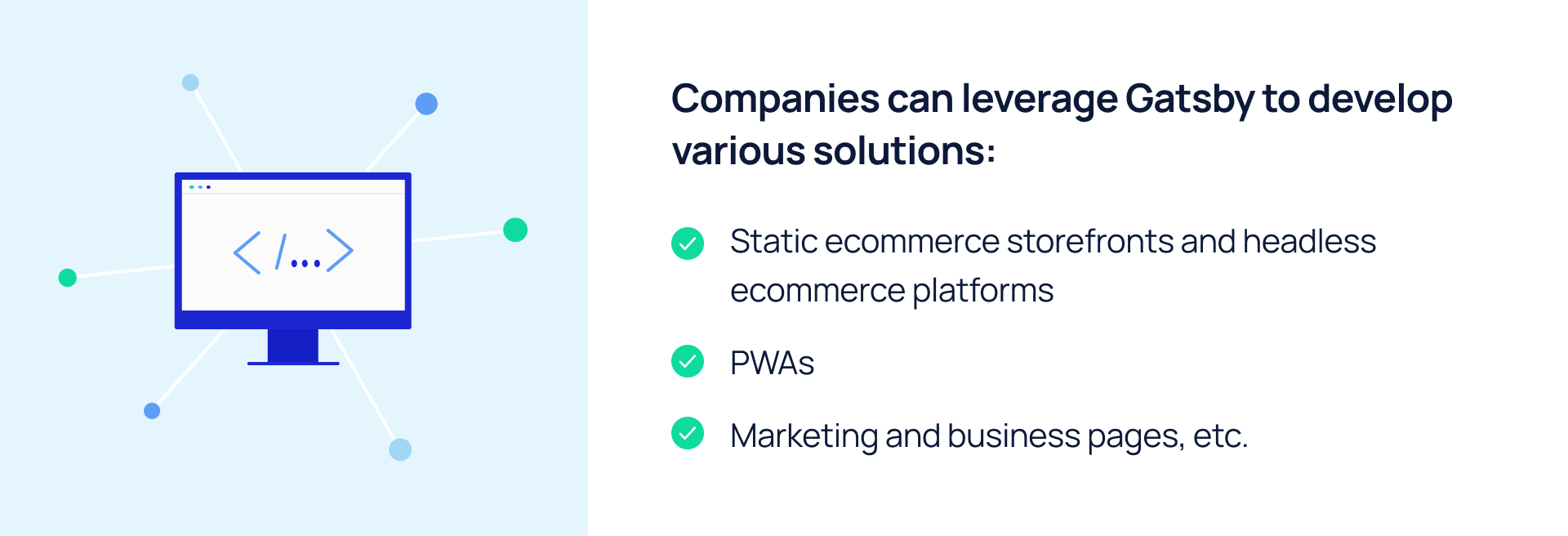GatsbyJS: one of the most popular static site generators

Why is Gatsby considered one of the top static site generators? If you want to know more about the functionality of this React-based framework, just dig in.
Having acknowledged that digitalization is inevitable, healthcare businesses have become strongly motivated to reinforce their online presence. But, inadequacies such as shot slow site loading, poor SEO, and disregard for user experience are the main components that will leave you behind your competitors. Thus, wishing to dominate the digital race, every healthcare company has to concentrate on improving these paramount issues.
The key here is to choose a technology designed to meet your business needs. For example, one of the technology options could be Gatsby, with more than 90,000 users[1]. So let's dive into the details and break down what makes this a good choice for your better website performance.
What is Gatsby?
Gatsby.js is an open-source front-end framework based on React, which is used to build SEO-friendly future-proof web apps and Jamstack full-fledged websites with fast loading and excellent performance.

Also, Gatsby is considered one of the powerful Static Site Generators (SSG) but is not limited to it: server-side rendering (SSR) and deferred static generation (DSG) modes are also available.
It is always propitious to have a wide choice. But when it comes to picking page rendering modes to achieve better site performance, questions often emerge. So let's go in-depth into a comparison of SSG and SSR for you to come up with an informed decision.
SSG vs. SSR
I would like to begin by clarifying that there are no winners in this battle, as both page rendering methods have flaws and strengths. So the answer is therefore rather ambiguous: it all depends.
SSG is a long-time Gatsby's rendering mode. The essence of this mode is that the user-facing HTML of the page is produced at build time. In more detail: the SSG builds static "routes" that include the page data, which are then converted into static pages (at build time), bypassing the time-consuming conversion phases and delivering directly to the client. So, the page's content is generated before users' requests.
SSG is a good choice for web pages that do not need to be personalized for each user (landings, home pages, documentation, etc.). However, since all website pages are generated upfront, it is complicated to update the site's content (HTML needs to be re-generated for each content refresh). Therefore it is not a suitable solution for sites with regular content updates.
Statically generated sites provide high-load speed, optimized SEO, and better performance —all that is of value to today's demanding customers. Moreover, static sites are database-and-server-independent, which enhances their security.

Compared to SSG, server-generated sites imply that the process of building a page begins after the client's request rather than being done in advance. In this case, the page (code) is generated on the server at runtime, and thus the client receives the “freshest” content, although possibly with a time lag. In addition, the server can refer to the database for the required information, which is helpful for personalization.
SSR would be a suitable option for dynamic sites with frequent content updates (news sites, for example). This approach will be SEO-friendly too.
The drawback of SSR is the possible slow page load time and the overburdening of the server with unnecessary work (e.g., when several users request the same page), so it can be costly and resource-intensive.
Gatsby's top features
The React-based framework is flexible enough, technically friendly, and full of plugins to create state-of-the-art websites and web apps.
The leverage of GraphQL data layer and Webpack module bundler enable all data sources collection. Gatsby also lets you bring in data from various sources: content management systems (CMSs), SaaS services, Markdown files, APIs, and databases. It enables companies to integrate other solutions into their site and thus make business running more streamlined.
Here are a few more core perks in using Gatsby:

Seamless Integration with CMS
Strapi, Contentful, Tina, Prismic are some of the headless content management systems Gatsby can "collaborate" with. In addition, it is possible to make a content match using multiple CMSs simultaneously. As a result, Gatsby and CMS synergy ensure seamless content management and delivery, hindering either developers or marketers.
Effortless maintenance and development
In contrast to WordPress, upgrading to a new major Gatsby version for its seamless running isn’t essential (although it can be beneficial). This way, we can keep security and performance issues at a stable level.
Gatsby provides a streamlined engineer experience where front-end developers can focus on providing an advanced interface using Gatsby's minimal and intuitive toolkit. In addition, a clear separation of backend and front-end tasks allows both front-end developers and backend developers to focus on what they do best and thus produce optimized synchronization to deliver an effective solution.
Regarding the backend: working with Gatsby, you are free to use a custom backend. Also, one option for using Gatsby is a GIT repository with markdown files as backend in sync with the Netlify CMS, for example, which makes site content delivery faster and its further maintenance streamlined.
Jamstack supporter
Developing websites with Gatsby means diving into the Jamstack culture. It is a kind of web architecture, including JavaScript, APIs, and Markup, without the need for a database.
This approach to website development brings with it the benefits of robust performance and site security, a rich development experience, and seamless scalability.
Cloud opportunities
The Gatsby cloud platform makes it possible to easily and securely build, preview and deploy websites while hosting your Gatsby site to AWS. By adding Amazon CloudFront (CDN), your site has a great chance of being as speedy as possible and making file hosting quite budget-effective.
Solid security
To summarize the list of Gatsby's functionality, it is impossible not to mention its security.
The main security risk of websites lies in the presence of a service that can become a target for hacking. However, Gatsby is a serverless technology with an inaccessible database in most cases (although the exception may be in the case of headless CMS usage but getting to the database is still far from easy). So, there is no risk of DDOS attacks, malicious requests, or other hacking scams.
What are the alternatives to Gatsby?
Gridsome, Eleventy, Hugo, Next.js are some popular alternatives (among 50+) to Gatsby. According to Padepro, Gatsby is considered the top SSG left behind Jekyll, Next.js, Hugo, and Nuxt.js [2].

In the Software House's 2020 study [3], Gatsby was the most used static site generator, getting ahead of the Next.js, according to the 4,500 developers surveyed. However, today, Next.js is regarded as Gatsby's foremost competitor.
With 56,000 Gatsby websites already launched [4], this open-source framework can be deemed successful. But it has room for improvement, and I think Gatsby will soon offer many more robust features that developers and non-tech specialists alike will appreciate.
In conclusion
With all its powerful technical stack, Gatsby delivers fast, interactive, and, importantly in digital health, secure websites.
To realize Gatsby's full potential and professionally implement all your business ideas, you need a React-familiar MedTech team. We're here to cooperate — just drop us a line.
References:
- https://www.forbes.com/sites/davidjeans/2020/05/27/gatsby-website-building-startup-backed-by-index-ventures-raises-28-million/?sh=5c67b1b47f3e
- https://pagepro.co/blog/gatsbyjs-alternatives/
- https://tsh.io/state-of-frontend/#frameworks
- https://www.wappalyzer.com/technologies/static-site-generator/gatsby
- https://www.gatsbyjs.com/docs/conceptual/rendering-options/
- https://www.similartech.com/technologies/gatsby
- https://openbase.com/js/gatsby/documentation
 Medical Content Creation
Medical Content Creation
 Digital Product Development
Digital Product Development
 Growth Marketing
Growth Marketing
